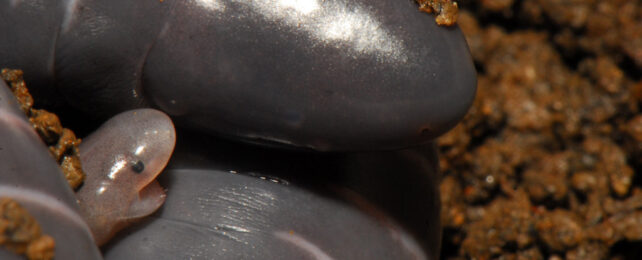Caecilian mothers grow a fatty skin layer for their babies to tear off and eat. It offers not only nourishment for their offspring but also microbes, providing a starter kit for their young's own microbiome, new research has discovered.
Caecilians are weird, mysterious creatures. They look sort of like huge worms or small snakes, but they're really limbless amphibians, lesser-known relatives of frogs and salamanders. They lead secretive lives, generally hidden from view in soil or stream beds.
"There's still a remarkable amount of caecilian biology that we just don't know anything about, mostly because they can be hard to find," says senior author David Blackburn, herpetology curator for the Florida Museum. "To our knowledge, this is the first published study of a caecilian microbiome."
What little we do know about caecilians invites more curiosity. They can be surprisingly doting parents, especially by amphibian standards. In some species, mothers provide the skin meals for their young, who have uniquely adapted baby teeth to help them eat it.
Many animals are known to pass microbes to the next generation through parental care in some way, but this is the first direct evidence of it happening in any amphibian. And of all the amphibian species it could be, the study's authors found this happening in caecilians.
Although caecilians are enigmatic, their parenting skills may make them better subjects for studying this phenomenon than more well-known amphibians.
Previous studies of amphibian microbiomes have yielded few conclusive results, the researchers explain, mainly because so few frog and salamander species provide any parental care for their offspring beyond laying eggs.
On the other hand, baby caecilians may receive significant care from their mothers. Even after the period of skin feeding (or maternal dermatophagy) ends, a mother and her babies often stay together, the researchers note, coiling up together as a family.
"When you find the eggs, you always find the mother," says University of Florida herpetologist Marcel Talla Kouete. "I've never seen a juvenile without an attending mother."
Kouete and his colleagues were curious if maternal dermatophagy might be more than just a food supply, perhaps helping baby caecilians gain valuable microbes in a way comparable to how human babies acquire microbes from the birth canal and breastmilk.
They sought answers by studying the Congo caecilian, Herpele squalostoma, a Central African species that exhibits maternal dermatophagy.

The researchers collected samples from the skin and guts of several caecilians – 14 juveniles and 15 adults – and sequenced any bacteria living there, along with bacterial colonies from the surrounding environment.
The study found that bacteria from the environment were the least important source for microbiomes of young caecilians. But all juveniles shared at least some of their skin and gut microbiomes with their mothers, which they obtained via both skin feeding and coiling.
As with humans, a major motivation for studying the microbiome of caecilians and other amphibians is the hope of learning how microbes influence the animals' overall health.
"Is there an evolutionary advantage?" Kouete asks. "If so, are these benefits absent when parental care is circumvented?"
With caecilians still so shrouded in mystery, new details like this can go a long way toward expanding our understanding of their biology and possibly even their ecological roles.
"This study is a bit like going out into the world and figuring out all the frogs that live in a forest," Blackburn says. "We might find ground frogs, tree frogs, and burrowing frogs; big species and small; ones that breed in this way or that way."
"Based on those characteristics, you could start inferring what role they play in the forest ecosystem, which is what we'd like to do with the caecilian microbiome," he says.
The study was published in Animal Microbiome.
